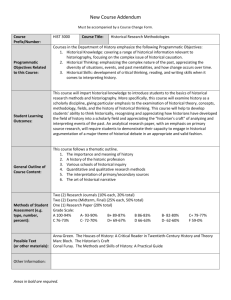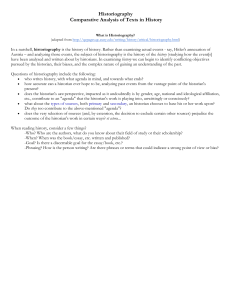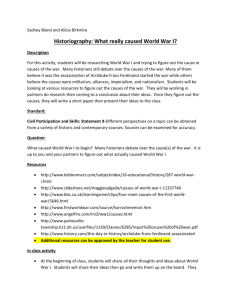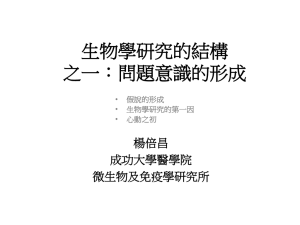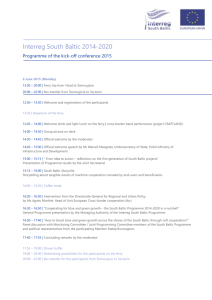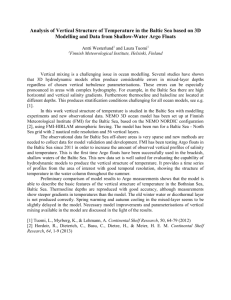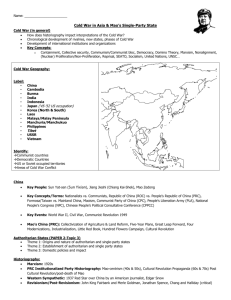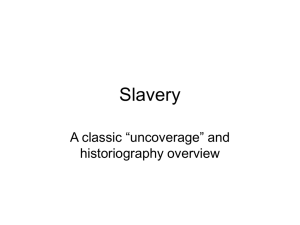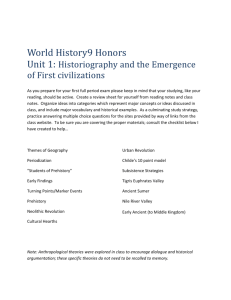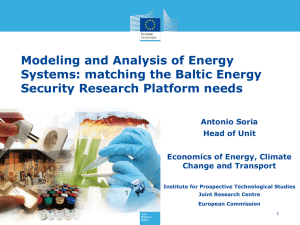Agnepilogy applied to history
advertisement
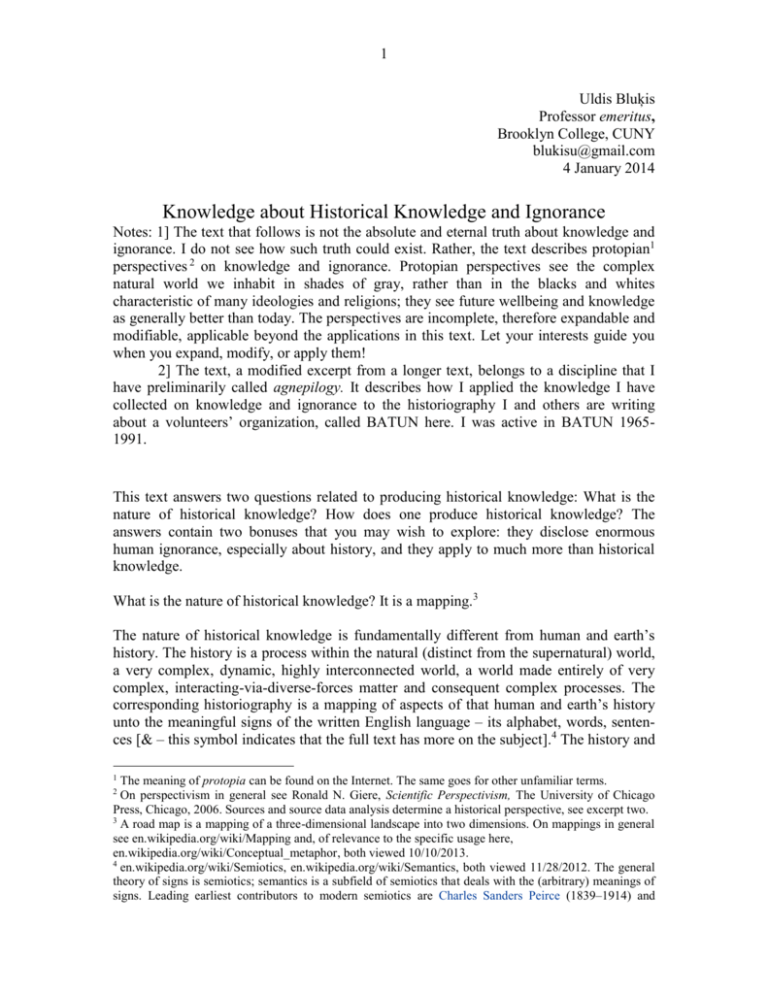
1 Uldis Bluķis Professor emeritus, Brooklyn College, CUNY blukisu@gmail.com 4 January 2014 Knowledge about Historical Knowledge and Ignorance Notes: 1] The text that follows is not the absolute and eternal truth about knowledge and ignorance. I do not see how such truth could exist. Rather, the text describes protopian1 perspectives 2 on knowledge and ignorance. Protopian perspectives see the complex natural world we inhabit in shades of gray, rather than in the blacks and whites characteristic of many ideologies and religions; they see future wellbeing and knowledge as generally better than today. The perspectives are incomplete, therefore expandable and modifiable, applicable beyond the applications in this text. Let your interests guide you when you expand, modify, or apply them! 2] The text, a modified excerpt from a longer text, belongs to a discipline that I have preliminarily called agnepilogy. It describes how I applied the knowledge I have collected on knowledge and ignorance to the historiography I and others are writing about a volunteers’ organization, called BATUN here. I was active in BATUN 19651991. This text answers two questions related to producing historical knowledge: What is the nature of historical knowledge? How does one produce historical knowledge? The answers contain two bonuses that you may wish to explore: they disclose enormous human ignorance, especially about history, and they apply to much more than historical knowledge. What is the nature of historical knowledge? It is a mapping.3 The nature of historical knowledge is fundamentally different from human and earth’s history. The history is a process within the natural (distinct from the supernatural) world, a very complex, dynamic, highly interconnected world, a world made entirely of very complex, interacting-via-diverse-forces matter and consequent complex processes. The corresponding historiography is a mapping of aspects of that human and earth’s history unto the meaningful signs of the written English language – its alphabet, words, sentences [& – this symbol indicates that the full text has more on the subject].4 The history and 1 The meaning of protopia can be found on the Internet. The same goes for other unfamiliar terms. On perspectivism in general see Ronald N. Giere, Scientific Perspectivism, The University of Chicago Press, Chicago, 2006. Sources and source data analysis determine a historical perspective, see excerpt two. 3 A road map is a mapping of a three-dimensional landscape into two dimensions. On mappings in general see en.wikipedia.org/wiki/Mapping and, of relevance to the specific usage here, en.wikipedia.org/wiki/Conceptual_metaphor, both viewed 10/10/2013. 4 en.wikipedia.org/wiki/Semiotics, en.wikipedia.org/wiki/Semantics, both viewed 11/28/2012. The general theory of signs is semiotics; semantics is a subfield of semiotics that deals with the (arbitrary) meanings of signs. Leading earliest contributors to modern semiotics are Charles Sanders Peirce (1839–1914) and 2 2 the historiography – a historical knowledge map encoded in semiotic signs – reside in two fundamentally different universes or domains. Any historiography is but an incomplete mapping of history. Historiographies that strive to be unbiased can help us understand history. Deliberately or unintentionally biased ones will mislead about historical events. Above all, whatever history is not in any historiography is a part of human ignorance. More knowledge of human ignorance comes from examining the production of historical knowledge. How does one produce historical knowledge maps? From sources and source data analyses. Maps of the same history, produced from different sources and/or analyses, are different perspectives on the history. [Another important knowledge source is what we imagine and believe. This source is not discussed here.] The tools of analysis are many. An example of an analytic tool is systems thinking, useful beyond history.5 Systems or systemic thinking refers to tools for generating useful knowledge about complexity. A different tool – reductionism – has been dominant and successful in natural sciences 6 where it seeks to reduce phenomena to a few simple fundamentals, as the fundamental particles of physics. Systems thinking complements reductionism. A reductionist is a specialist or expert in a discipline, such as fundamental particle physics. A systemic thinker is a generalist, such as farmer who knows something of agriculture, climate and weather, markets, ecology. The generalist seeks to specify a system that includes the relevant, interacting elements making up complex phenomena, as history. A quotidian example of a simple system is the lists many of us make before beginning an activity such as shopping. A more sophisticated way to model a system is as a network of elements or nodes that interact or link via signals between the nodes. A history may be modeled as a probabilistic multi-causal social network of actors/resources – institutions and individuals, limited resources that the actors consume – linked directly, indirectly, through feedback or unidirectional events that signal the actors to act. 7 The multiple earlier events that cause a given event may occur serially or in parallel [&]. Ferdinand de Saussure (1857–1913). Being made of matter, as printers’ ink, signs are a part of the natural world. The ability of matter to express meaning is one of its many properties 5 Peter M. Senge, The Fifth Discipline: The Art & Practice of the Learning Organization, Currency Doubleday, New York, 1990. The fifth discipline is systems thinking. Other authors use different phrases that mean essentially the same as “systems thinking". “Complex adaptive systems” are used in Robert Axelrod and Michael D. Cohen, Harnessing Complexity: Organizational Implications of a Scientific Frontier, The Free Press, New York, 1999. “Systemic thinking”: Lester R. Brown, Breaking New Ground, W. W. Norton & Company, New York, 2013. 6 The fathers of modern science, as Isaac Newton or Galileo Galilei, were faithful, although not necessarily the most church-obedient Christians. It is likely that the “reductionism” of monotheistic religions, where a god is the fundamental/final cause of everything, has contributed to the popularity of reductionism in modern science. 7 Albert-Laszlo Barabassi, Linked: The New Science of Networks, Perseus Publishing, Cambridge, MA, 2002. Stephen Wolfram, A New Kind of Science, Wolfram Media, Inc., Champaign, IL, 2002, viewed on 3 Systems thinking can help reveal the broad ignorance that humans inevitably must have, for diverse reasons, about the complex world they live in. All aspects of nature are not equally generous with respect to sources of knowledge. Histories are stingy is two major ways. First, the history of humans, but also of rocks (geology) or life (Darwinian or evolution science) – cannot be reproduced in the present, unlike the endlessly reproducible laboratory experiments of the natural sciences. The American polymath Kenneth Boulding distinguished between soft and hard knowledge. All historiography is soft knowledge, unlike the hard knowledge about the simpler ahistorical aspects of the natural sciences, especially of physics, chemistry, and more recently – molecular biology. Second, the limits on primary source data are severe: preserved sources retain but a small fraction of a history. (Secondary sources are derived solely from primary ones. The secondary sources the author used i] are indirectly subject to the primary sources’ limits; ii] belong to two kinds: eclectic secondary sources, as well as the author’s eclectic memory of what he read and heard about world events during his life back to about 1940.) Primary sources contain the preserved evidence of past events – typically eclectic and dynamic memories (often preserved in oral histories), artifacts, and, most important for much modern history, the event-related documents – that is bound to be much less than existed at the time of the events. To appreciate the severe limits of actual sources imagine a primary source as complete as possible: a diary or map that has recorded in every detail all historical events of interest. In the case of BATUN its diary would attempt to record all of the history of the organization BATUN during 1966-1991. It would record everything that happened dayby-day within and directly connected to BATUN, such as what its Baltic activists thought about BATUN; their interactions among themselves during all BATUN meetings, on BATUN matters at the bar of the Estonian House in New York (where BATUN’s board held most of its meetings) and elsewhere, via letters and phone; their interactions with BATUN’s contacts – the UN Member State diplomats, other Baltic exiles, Baltic nationalists in BS, and others; the contacts’ reactions to BATUN and interactions among themselves, both personally and as representatives of States and organizations. 7/2/2012 at wolframscience.com/reference/notes/1032f. en.wikipedia.org/wiki/Social_network, viewed 9/20/2013. For an example from a different history see Peter Longerich, Holocaust: The Nazi Persecution and Murder of the Jews, Oxford University Press, New York, 2010: in his introduction the author views, on p. 6, the Nazi’s Judenpolitik as a highly complex system/network or “a highly complicated decisionmaking process.” 4 The historiography of BATUN was written from a much narrower primary source than the imagined diary. The actual major source was BATUN’s Archive that contains mostly documents, as well as a few artifacts (photographs, demonstration placards, a Baltic flag, computer discs). The memories of the former BATUN activists who were also the authors of the historiography were less significant primary sources, as were several external documents from the archive of the UK Foreign Office. In sum, this historiography is a tale told from an overwhelmingly internal perspective – that of the activist members of BATUN as recorded in the Archive and remembered (&). This internal-perspective historiography is further limited, because the Archive was compiled by amateurs and has never seen professional care. Some of the documents it once contained may have been destroyed, for example, in 1985 when the office of BATUN moved. Parts of it are chaotic – increasing the likelihood that authors have missed significant documents. Volunteers wrote many of the papers found in it. Many of the volunteers did not have training or experience relevant to the subject matter of a particular paper; they relied on a few secondary sources. A core part of the Archive is three incomplete sets: the minutes of the board of BATUN (BM), the annual President’s Report (PR), and the minutes of the annual meeting (AM). If the volunteer takers of the minutes were new to BATUN, they could easily misunderstand and make an erroneous record of aspects of a meeting. Only some of the errors were corrected in the minutes of the next meeting. Overall, the documents reflect decisions better than the decision-making processes8 and their implementation. For these and other reasons this historiography must reflect the history of BATUN less well than would a historiography of, say, the more professional Foreign Ministry of a State. In future BATUN’s historiography could be expanded beyond the limits of this internalperspective through including the external perspectives of those institutions – first of all the Member States of the UN and Baltic exile organizations – and individuals who either influenced BATUN or were influenced by it. These influences could be direct or indirect. The European Parliament influenced BATUN directly when it passed a Baltic resolution in 1983. The 45 Baltic dissidents who made a declaration on 23 August 1979 that elicited the EP resolution had one indirect influence on BATUN – through the EP [&]. In very few cases the authors can present limited information about BATUN as seen from these external perspectives. Mostly, the authors merely identify the relevant institutions or individuals. 9 Contributions from the external perspectives would have to be extracted from other archives, some not yet open to research, such as of the Foreign Ministries of UN MS, of Baltic exile and homeland institutions, as well as the minds, some already inaccessible forever, of individuals, such as the diplomats who hosted BATUN delegates and Baltic non-BATUN activists who interacted with BATUN. 8 It was different at the British Foreign Office. Its archives contain correspondence among its members that is about making decisions, for example, how to respond to Baltic Appeal to UN’s visit in January 1966 to the UK mission that asked to raise the Baltic Question in the Decolonization Committee [&]. BATUN’s Archive holds little that is similar. There are many proposals for action from BATUN’ s activists, but practically no written back-and-forths among activists [&]. 9 The archive of the UK Foreign Office has been researched by the Latvian historian Anatolijs Zunda [&]. 5 In sum, this historiography is really an island of soft knowledge in an ocean of ignorance. As all islands do, it may change in the future. Expand? Also, there is wisdom in paying attention to the much-ignored ocean.
